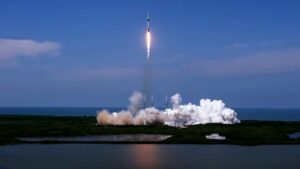SpaceX sets Falcon 9 fairing reuse mark with Starlink launch
By Jeff Foust

WASHINGTON — A SpaceX Falcon 9 launched another set of Starlink satellites May 26 on a launch that highlighted an often-overlooked aspect of the company’s reusability efforts.
The Falcon 9 lifted off from Space Launch Complex 40 at Cape Canaveral Space Force Station in Florida at 2:59 p.m. Eastern. The rocket’s upper stage released its payload of 60 Starlink satellites into orbit 64 minutes later.
The rocket’s first stage landed on a droneship in the Atlantic eight and a half minutes after liftoff. In contrast to some recent Starlink launches, where the Falcon 9 boosters had launched as many as 10 times, this Falcon 9 first stage was on only its second launch, having previously been used to launch the Sentinel-6 Michael Freilich ocean science satellite in November 2020.
SpaceX did set a different kind of reuse milestone on this launch. One of two halves of the payload fairing was on its fifth flight, the first time a payload fairing section had flown five times. The fairing half flew on four previous Starlink launches dating back to 2019. The second fairing half was on its third launch, having been used previously on a Starlink launch and the Transporter-1 rideshare mission in January.
The launch was also the 40th Falcon 9 mission to fly at least one reused payload fairing half. The company had quietly made regular use of previously flown payload fairings, which deploy parachutes after separation from the rocket’s upper stage and are recovered in the ocean by boats.
SpaceX Chief Executive Elon Musk said several years ago that the company would attempt to recover and reuse payload fairings because of their expense: about $6 million each. “Imagine if you had $6 million in cash in a pallet flying through the air, and it was going to smash into the ocean. Would you try to recover that? Yes, yes you would,” Musk said in 2017, after the company launched its first reused Falcon 9.
Unlike the booster landings, which the company broadcasts on its launch webcasts, the fairing recoveries take place out of view. SpaceX would occasionally provide video of attempts to catch the descending fairings in large nets strung above ships, but more recently has moved to simply recovering fairings from the water after splashdown.
This launch also marked the 100th consecutive successful Falcon 9 launch, a streak that started after a June 2015 launch failure on a NASA commercial cargo mission. That streak does not include the loss of the Amos-6 satellite when a Falcon 9 exploded during preparations for a static-fire test days before its scheduled launch in September 2016.
The launch brings the total number of Starlink satellites in orbit to 1,664. Viasat filed a motion with the Federal Communications Committee May 21 to stay its approval of a modification of SpaceX’s license that allows the company to increase the number of Starlink satellites it can operate in orbits about 550 kilometers high from 1,584 to 4,408. That would effectively block SpaceX from launching additional satellites until the FCC completed an environmental review of the constellation demanded by Viasat.
The FCC has not yet acted on the motion, and SpaceX did not mention the dispute in its launch webcast, which instead noted that the company has expanded the beta test of the Starlink service to residents of Belgium and the Netherlands.
May 27, 2021 at 02:26AM
via SpaceNews read more...

Post a Comment